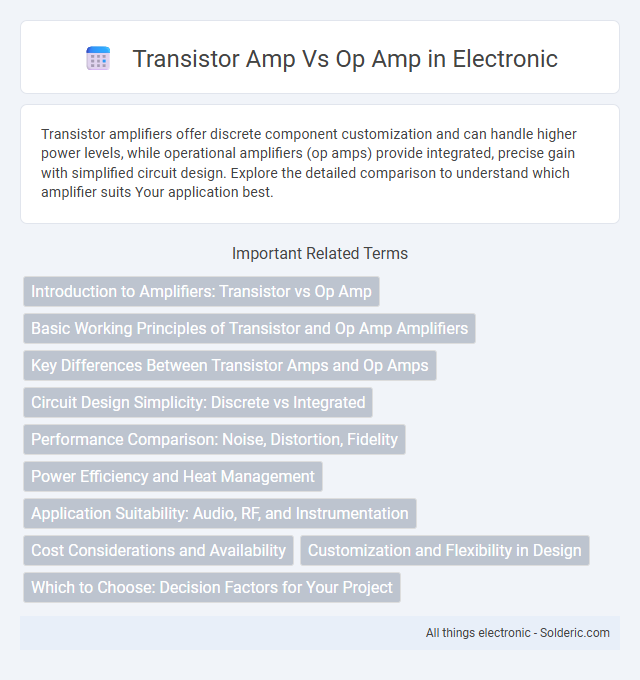Transistor amplifiers offer discrete component customization and can handle higher power levels, while operational amplifiers (op amps) provide integrated, precise gain with simplified circuit design. Explore the detailed comparison to understand which amplifier suits Your application best.
Comparison Table
| Feature | Transistor Amplifier | Operational Amplifier (Op Amp) |
|---|---|---|
| Device Type | Discrete semiconductor component | Integrated circuit with multiple transistors |
| Gain | Moderate, depends on transistor and configuration | Very high open-loop gain (typically > 100,000) |
| Complexity | Simple mono or multi-stage setups | Highly integrated, complex internal circuitry |
| Input Impedance | Low to moderate, depends on design | High (typically megaohms) |
| Output Impedance | Moderate to high | Low, suitable for driving loads |
| Power Supply | Single or dual supply, varies | Typically dual power supply (+/-15V common) |
| Frequency Response | Limited by transistor and circuit design | Wide frequency range, up to MHz or higher |
| Applications | Basic amplification, switching | Signal conditioning, filtering, integration, amplification |
| Cost | Low cost for individual devices | Moderate cost but multifunctional IC |
| Example Components | 2N2222, BC547 | LM741, TL081, LM358 |
Introduction to Amplifiers: Transistor vs Op Amp
Transistor amplifiers utilize individual semiconductor devices to amplify signals with high gain and are ideal for discrete, low-power applications. Operational amplifiers (op amps) integrate multiple transistors and components on a single chip, offering versatility, high input impedance, and stable gain for precision analog signal processing. The choice between transistor amps and op amps depends on factors such as circuit complexity, gain requirements, and frequency response.
Basic Working Principles of Transistor and Op Amp Amplifiers
Transistor amplifiers operate by varying the current flowing through a semiconductor junction, controlled by the input voltage at the base terminal, which allows for signal amplification via current gain. Operational amplifiers (op amps) use a differential input stage to amplify the voltage difference between two inputs with very high gain, enabling precise linear amplification and feedback control. Unlike transistors that amplify current directly, op amps provide voltage amplification with high input impedance and low output impedance, making them versatile for signal conditioning and analog computation.
Key Differences Between Transistor Amps and Op Amps
Transistor amplifiers use individual transistors as the primary amplifying element, offering discrete control over gain and frequency response but generally requiring more external components for biasing and stabilization. Operational amplifiers (op amps) integrate multiple transistors and other components into a compact IC, providing high gain, input impedance, and stability with minimal external circuitry. Key differences include the complexity of design, ease of use, bandwidth, and typical applications where transistor amps excel in custom, high-power scenarios while op amps are preferred for precision, low-noise amplification tasks.
Circuit Design Simplicity: Discrete vs Integrated
Transistor amplifiers require complex discrete component arrangements, demanding precise biasing and component matching for stable operation, which increases circuit design complexity. Operational amplifiers (op amps) are integrated circuits combining multiple transistors and feedback networks, simplifying design with standardized pin configurations and built-in gain stages. Your choice influences development time and ease of implementation, with op amps offering streamlined circuit design compared to discrete transistor amplifiers.
Performance Comparison: Noise, Distortion, Fidelity
Transistor amplifiers typically exhibit higher noise and distortion levels compared to operational amplifiers due to their discrete component nature and less integrated feedback control. Operational amplifiers offer superior fidelity with lower noise figures and minimal harmonic distortion, benefiting from advanced semiconductor fabrication and built-in compensation techniques. The enhanced linearity and bandwidth of op amps make them preferable for high-precision audio and instrumentation applications where signal integrity is critical.
Power Efficiency and Heat Management
Transistor amplifiers typically offer higher power efficiency due to their simpler circuit design and direct current control, resulting in less energy loss compared to operational amplifiers. In contrast, op amps often dissipate more heat because of their internal circuitry, which requires additional power for biasing and feedback mechanisms, necessitating more robust heat management solutions. Efficient heat sinks and thermal management are critical in both devices, but transistor amplifiers generally generate less thermal stress, improving overall reliability in power-sensitive applications.
Application Suitability: Audio, RF, and Instrumentation
Transistor amplifiers excel in high-frequency RF applications due to their superior gain-bandwidth product and low noise characteristics, making them ideal for radio transmitters and receivers. Operational amplifiers (op amps) are more suitable for audio and instrumentation uses, providing stable voltage gain, high input impedance, and precise signal conditioning in audio preamps and sensor interfaces. You should choose transistor amps for RF circuits demanding high-frequency response and op amps for accurate, low-frequency audio and instrumentation tasks.
Cost Considerations and Availability
Transistor amplifiers typically offer a lower-cost solution due to their simpler design and widespread availability of discrete transistors. Operational amplifiers (op amps) often come as integrated circuits, which may increase cost but provide increased functionality and consistent performance. Availability of op amps is generally higher in standardized packages, while transistor amps require sourcing individual components, potentially impacting lead times and pricing volatility.
Customization and Flexibility in Design
Transistor amplifiers offer superior customization and flexibility in design by allowing precise control over individual components such as biasing, gain, and frequency response, enabling tailored solutions for specific circuit requirements. Op amps provide ease of use and consistent performance with standardized configurations but are less adaptable to unique or highly specialized applications. Choosing a transistor amp grants your designs the ability to be finely tuned for optimal performance in bespoke analog circuits.
Which to Choose: Decision Factors for Your Project
Choosing between a transistor amplifier and an operational amplifier depends on factors like gain stability, frequency response, and circuit complexity. Transistor amps offer high current gain and are ideal for simple, low-frequency applications requiring discrete component control. Op amps provide versatile, integrated solutions with precise gain, high input impedance, and extensive feedback options, making them suitable for complex, high-accuracy signal processing tasks.
transistor amp vs op amp Infographic

 solderic.com
solderic.com